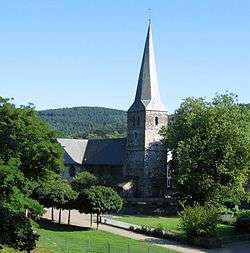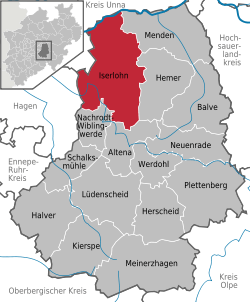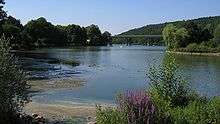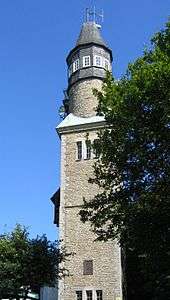Iserlohn
| Iserlohn | ||
|---|---|---|
 Bauernkirche | ||
| ||
 Iserlohn Location of Iserlohn within Märkischer Kreis district  | ||
| Coordinates: 51°23′N 07°40′E / 51.383°N 7.667°ECoordinates: 51°23′N 07°40′E / 51.383°N 7.667°E | ||
| Country | Germany | |
| State | North Rhine-Westphalia | |
| Admin. region | Arnsberg | |
| District | Märkischer Kreis | |
| Government | ||
| • Mayor | Peter Paul Ahrens (SPD) | |
| Area | ||
| • Total | 125.5 km2 (48.5 sq mi) | |
| Elevation | 494 m (1,621 ft) | |
| Population (2016-12-31)[1] | ||
| • Total | 93,197 | |
| • Density | 740/km2 (1,900/sq mi) | |
| Time zone | CET/CEST (UTC+1/+2) | |
| Postal codes | 58636–58644 | |
| Dialling codes |
02371 (Iserlohn) 02374 (Iserlohn-Letmathe) 02304 (Schwerte,Iserlohn-Hennen) 02352 (Altena,parts of Iserlohn-Kesbern) 02378 (Fröndenberg- Langschede, Iserlohn-Drüpplingsen) | |
| Vehicle registration |
MK, IS until 1974 LS until 1979 | |
| Website | www.iserlohn.de | |


Iserlohn (German pronunciation: [iːzɐˈloːn]) is a city in the Märkischer Kreis district, in North Rhine-Westphalia, Germany. It is the largest city by population and area within the district and the Sauerland region.
Geography
Iserlohn is located at the north end of the Sauerland near the Ruhr river.
History
The Pancratius church (also called Bauernkirche) was founded in around 985, but the first written document mentioning lon dates only from 1150. In 1237 the Count of the Mark gave Iserlohn municipal rights. In 1975 the city, which had been an urban district before, incorporated the surrounding ex-municipalities of Letmathe, Hennen, Sümmern and Kesbern, and became part of the district "Märkischer Kreis". As a larger mid-sized city, Iserlohn, however, still has a special status as compared to most other municipalities in the district. This means that the city takes on tasks more usually performed by the district (e.g. social and youth affairs) so that in some ways it is comparable to an urban district.
Points of interest
The Dechenhöhle was discovered in 1868 during the construction of the railway line Hagen-Iserlohn. 360m are accessible for visitors, and there are lots of stalactites in the cave.
The Danzturm, located on the southern hill overlooking the old city, is a landmark and featured on the logo of the local brewery (Iserlohner). The tower has views of the valley and surrounding hills and is open to the public with a small inn at the base.
In the 18th Century, the town became known for its Iserlohn boxes, a form of tobacco or snuff box with an engraved or embossed lid that often featured an image of Frederick the Great.[2]
Sports
The city is home of the Iserlohn Roosters, a DEL (first-division) ice hockey team. The Roosters joined the DEL in 2000 and developed from a low-budget team to a solid one that regularly competes for a Playoff-spot. The club plays its home games at the Eissporthalle Iserlohn, which holds 4,967 spectators. The original club, EC Deilinghofen, was founded in 1959 and went bankrupt in 1987. The second club, ECD Sauerland, existed from 1988 to 1994. In 1994, Iserlohner EC was founded.
Education
Iserlohn has 15 elementary schools and 13 secondary schools (4 Gymnasien, 1 Gesamtschule, 3 Realschulen, 5 Hauptschulen).
Two universities of applied sciences are also located in the city. The headquarters, together with a major branch, of the South Westphalia University of Applied Sciences (also: Fachhochschule Südwestfalen (FH SWF)) offering engineering and informatics programmes is located in the city centre on Alexanderhöhe.[3] The Business and Information Technology School (BiTS) is a private, state-approved business school with a campus near the Seilersee.[4]
Schützenfest
The Schützenfest is an annual part of Iserlohner's cultural life. It is held at the Parkhalle, Alexanderhöhe, and the Friedensfest at Bauernkirche.
Coat of arms
In the middle of the coat of arms is Saint Pancras (St. Pancratius), patron of the oldest church in Iserlohn. He is depicted between two towers of the historic city wall. The checked fess below the saint is derived from the arms of the Counts of the Mark.
International relations
Iserlohn is twinned with:
- Almelo, Netherlands since 1954
- Biel/Bienne, Switzerland – since 1959
- Hall in Tirol, Austria – since 1967
- Wrexham, Wales, United Kingdom – since 1970
- Auchel, France – since 1975
- Laventie, France – since 1975
- Nyíregyháza, Hungary since 1989
- Novocherkassk, Rostov Oblast Russia – since 1990
- Glauchau, Saxony, Germany – since 1991
- Chorzów, Poland – since 2004
Notable people
- Curt Rechel (1902-1973) - Navy officer
- Gerd Roellecke (1927-2011) - jurist and legal philosopher
- Jochen Busse (born 1941) - actor and cabaret artist
- Ulrich Walter (born 1954) - astronaut
- Johann Stephan Pütter (1725-1807) Reichspublizist and teacher of state law
- Hugo Schultz (1838-1904) was a personality in the Ruhr mining industry and a nationalliberal politician
- Friedrich Soennecken (1848-1919) - businessman, entrepreneur, inventor and graphic artist
- Alexander Pfänder (1870-1941) - philosopher
- Karl Rasche (1892-1951), SS honor and rank leader for special use with the rank of Obersturmbannführer and board member and spokesman of the Dresdner Bank
- Wilhelm Wessel (1904-1971) - painter
- Aloys Kontarsky (1934-2017) - pianist
- Bernhard Kontarsky (born 1937 in Iserlohn) - conductor and pianist
- Harm Klueting (born 1949 in Iserlohn) - Roman Catholic clergyman, historian, theologian and university lecturer
- Volker Fischer (born 1950 in Iserlohn) - fencer
- Thomas Schmidt (1957) - Radio moderator
- Gordon Brown (born 1958) - sculptor
- Timothy Paul Evans (born 1962 in Iserlohn) - British general lieutenant and commander of the ARRC
- Matthias Mellinghaus (born 1965 in Iserlohn) - rowing sportsman, film director and assistant director, Olympiasieger 1988
- Marsha Wattanapanich (born 1970 in Iserlohn) - Thai singer and actress
- Markus Giesler (born 1976 in Iserlohn) - consumer researcher
- Sebastian Jones (born 1982 in Iserlohn) - ice hockey player
- Caput (born Soner Duman) (born 1983 in Iserlohn) - rapper
- Thore Schölermann (born September 26, 1984 in Iserlohn) - actor
- Dieter Orendorz (born 1992 in Iserlohn) - Ice Hockey Player
- David Beckmann (born 2000 in Iserlohn) - car racing driver
References
- ↑ "Amtliche Bevölkerungszahlen" (in German). Landesbetrieb Information und Technik NRW. Retrieved 2018-02-24.
- ↑ Fleming, John & Hugh Honour. (1977) The Penguin Dictionary of Decorative Arts. London: Allen Lane, p. 399. ISBN 0713909412
- ↑ "FH-SWF Iserlohn". fh-swf.de. 28 August 2013.
- ↑ Archived 27 January 2010 at the Wayback Machine.
Further reading
- Götz Bettge: Iserlohn-Lexikon. Iserlohn 1987. ISBN 3-922885-37-3.
- Ernst Dossmann: Iserlohner Tabaksdosen erzählen. Ein Einblick in die wirtschaftlichen, gesellschaftlichen, politischen und militärischen Verhältnisse und das Aufblühen von Gewerbe, Industrie und Handel im märkisch-westfälischen Wirtschaftsraum während der Regierungszeit Friedrichs des Großen, dargestellt an bekannten Iserlohner Industrieerzeugnissen. 1981. ISBN 3-922885-01-2.
- Margret Kirchhoff: Pulsschläge einer Stadt. Die Oberste Stadtkirche Iserlohn – Zeitbilder und Momentaufnahmen. 2003. Eigenverlag Dr. Margret Kirchhoff.
- Fritz Kühn: Liebes altes Iserlohn. (released about 1956). Westfalenverlag Dortmund
- Peter Müller und Günter Stalp: Unsere gute alte Straßenbahn. Eine Reise in die Vergangenheit. Iserlohn 1995. ISBN 3-922885-78-0.
- Hans-Herbert Mönnig Verlag Iserlohn (no author mentioned): Iserlohn – unsere lebendige Stadt. Ein Bildband von Iserlohnern für Iserlohner. Iserlohn 1997. ISBN 3-922885-93-4.
- Heinz Stoob (†): Westfälischer Städteatlas; Band: I; 9 Teilband (Stadtmappe Iserlohn). Im Auftrage der Historischen Kommission für Westfalen und mit Unterstützung des Landschaftsverbandes Westfalen-Lippe; edited by Heinz Stoob and Wilfried Ehbrecht. Dortmund-Altenbeken, 1975. ISBN 3-89115-336-8.
External links
| Wikivoyage has a travel guide for Iserlohn. |
| Wikimedia Commons has media related to Iserlohn. |
- Official website

- Newspaper Iserlohner Kreisanzeiger und Zeitung (in German)
